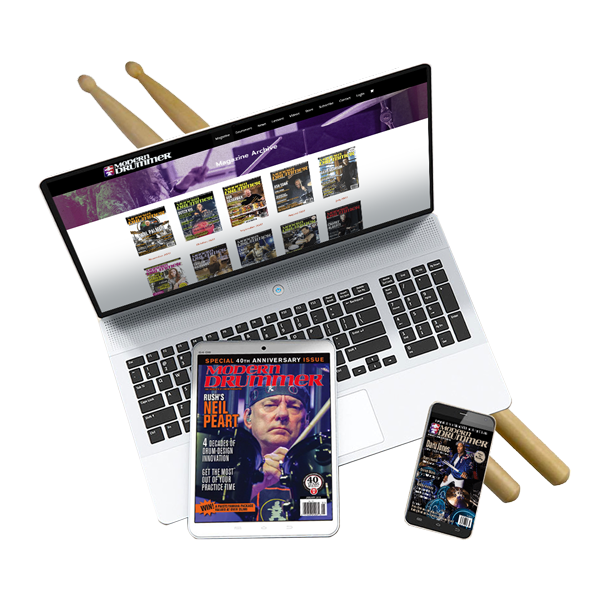June 2020 Issue – Volume 44 • Number 6
Articles in June 2020
Steve Jordan, June 1985
I had to prove to myself that I could swing. One night at the Blues Bar, Danny Aykroyd was playing the rough tapes of the Made in America album—the Blues Brothers album that no one has heard of. Keith…
1970: The Year in Drumming
As our previous special issues focusing on the years 1967 and 1969 revealed, the contributions of the greatest drummers of the era both mirrored and drove the rapidly evolving sounds of popular music. By the start of the ’70s, new…
The Pretenders’ Martin Chambers
The band’s founding drummer finds himself back on tape for the first time in years. If you’ve seen Martin Chambers live with the Pretenders in recent years, you can’t help but think that there aren’t many men pushing seventy that…
West Coast Pop Journeyman Johny Barbata
The creative and interpersonal chemistry that defined the work of David Crosby, Stephen Stills, Graham Nash, and Neil Young in 1970 was explosive, and the drummer was right smack in the middle of much of it. In the 1970s, Johny…
Fusion Star Lenny White
The four-time Grammy Award winner is such a versatile and influential drummer, composer, and producer, it’s easy to forget that he was barely out of his teens when he recorded four of the most important jazz records ever—and all in…
Rhythmic Emotion -A Masterclass in Applying Tension-and-Release to Your Drumming
Music has the uncanny ability to evoke emotions in the listener. For example, songs composed using major scales often sound happy, while minor chords can evoke melancholy. As drummers we might seem limited in this regard when compared to other…
Canopus Type-R Drumset
A deliberately more aggressive-sounding option from Japan’s premier boutique brand. Canopus started in 1977 primarily as a custom shop specializing in remaking some of the most coveted American drums of the twentieth century. The company went on to develop…
Bill Ward: Metal Drumming Godfather
“Oh no, I could never have imagined it,” says Bill Ward with a long pause of disbelief. The drummer is recalling last year, standing alongside his Black Sabbath bandmates, Tony Iommi and Geezer Butler, to receive the revered Lifetime Achievement…
Gregg Bissonette Breaks Down Tower of Power’s “What Is Hip?”
“One of the most classic songs on the drums is Tower of Power’s ‘What Is Hip?’ with the great David Garibaldi on drums,” says Gregg Bissonette via the video studio at DrumChannel.com. “David pioneered linear funk drumming, meaning that no…
Technique Vs. Musicality Remove Yourself and Let Nature Guide You
A lot of drummers like to pit technique and musicality against each other as if they’re polar opposites. But they’re actually very closely related. Many associate technique with speed or chops, but in reality technique is simply how you go…
Dream Eclipse Series Cymbals
A full range of half-lathed B20 models designed for maximum versatility. After considerable success with the original 21" Dark Matter Eclipse ride, Dream decided to flesh out a full setup of partially lathed cymbals. These new Eclipse series models include…
Jaki Liebezeit: The Life, Theory and Practice of a Master Drummer
It’s no accident that the rhythm-centric music of the German band Can is still considered cutting-edge decades after they first came to prominence. As a new book makes clear, much of their iconoclasm originated with their fascinating drummer. The late,…
Rubix Drums, London, England
Rubix is the newest drum retailer to open in London. It’s a drum store with a difference, whose proprietors are also trying to make a difference. The shop is only part of what the Rubix team does to serve the…
Welch Tuning Systems Artistry Series Drumset
A smooth, strong, and stable method for tensioning an entire drum with a single key. Stemming from founder Samuel Welch’s desire to create a drum tensioning system that allows the user to quickly “tune for the room,” Colorado-based Welch Tuning…
Latin-Jazz Great Jimmy Branly
We recently caught up with Cuban-born/L.A.-based drummer Jimmy Branly before a gig at the famed Baked Potato music club. There’s an obvious goal of versatility when it comes to Jimmy’s gear. In addition to the fusion-style setup shown here, Jimmy…
Reflections of My Life
Hi, and welcome to 1970! We editors really enjoy doing these theme issues, and we hope you take as much pleasure from them. In 1970, I was thirteen years old and had been playing drums for about five years. This…
The Big Beat of Hard-Bop Great Art Blakey
In both deeds and words, Art Blakey was the definition of a dedicated jazz musician, mentor, and musical messenger. His driving, thunderous, and propulsive playing style synthesized the rhythmic approach of West African drumming coupled with American blues. Among equals…
John Niekrasz of Method Body
Portland, Oregon, drummer and poet John Niekrasz converses like he plays, with an intense, burgeoning energy that manages to touch on a myriad of disparate inspirations at a rapid, fluent clip. This dovetails with his lifelong obsession with language…
Studio and Touring Great Jim Gordon
In 1970, Jim Gordon drummed on at least a dozen hit albums, including eight of the most indelible records in rock history: Eric Clapton and Leon Russell’s self-titled solo debuts, George Harrison’s All Things Must Pass, Dave Mason’s Alone…




